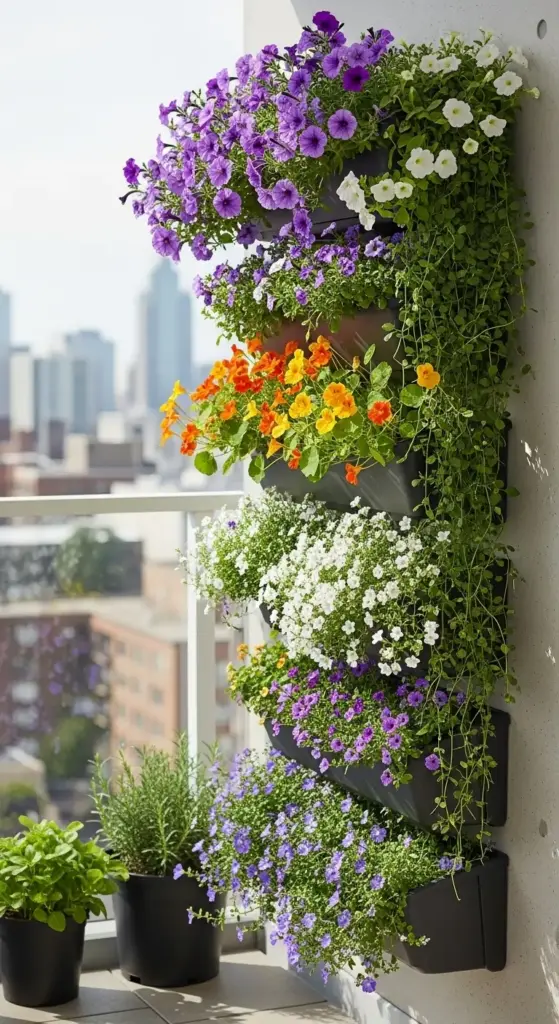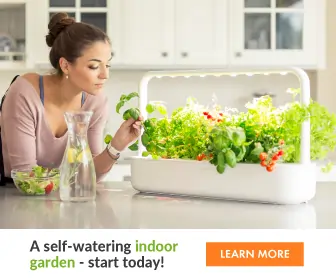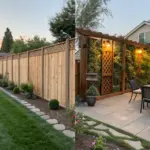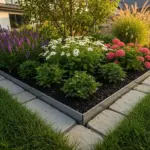3. Vertical Living Wall Flower Showcase

My first vertical garden was a complete disaster. I mounted a bunch of planters on my apartment balcony wall and watched everything die within two weeks.
Turns out, vertical gardening has its own set of rules.
Space-Saving Solutions for Tiny Urban Spaces
Living in a small apartment doesn’t mean giving up on your flower garden dreams. I learned this after moving from a house with a big yard to a studio with just a 4×6 balcony.
Vertical flower walls can give you 20+ square feet of growing space on a wall that’s only 4 feet wide. The math just makes sense when you’re working with limited space.
Wall-mounted planters are perfect for renters since most don’t require permanent installation. I use Command strips rated for outdoor use – they hold up to 15 pounds each.
Tiered plant stands create vertical growing space without mounting anything to walls. Mine holds 12 pots in the same footprint as 3 regular containers.
The key is thinking upward instead of outward. My current setup produces more flowers than my old ground-level garden ever did.
Best Flowering Plants for Going Vertical
Not all flowers are cut out for vertical growing conditions. I killed a lot of plants before figuring out which ones actually thrive growing sideways.
Petunias are absolute champions for vertical gardens. They cascade naturally and bloom continuously all summer long. The ‘Wave’ series is practically bulletproof.
Nasturtiums are perfect for beginners – they’re nearly impossible to kill and their trailing habit looks amazing in wall planters. Plus, the flowers are edible!
Bacopa creates those gorgeous waterfall effects you see in magazine photos. The tiny white or purple flowers bloom nonstop and handle heat surprisingly well.
Million bells (calibrachoa) look like mini petunias but are actually tougher. They don’t get leggy like regular petunias and bounce back from neglect.
For annual vines, morning glories and sweet peas add vertical height without taking up ground space. They’re like natural living curtains.
DIY Vertical Structures That Actually Work
I’ve built probably 15 different vertical garden structures over the years. Here are the ones that didn’t fall apart or kill my plants.
Pallet planters are everywhere on Pinterest, but most tutorials are garbage. The secret is lining them with landscape fabric and adding a drip tray at the bottom.
I attach small pots to the pallet slats using zip ties – way more secure than trying to plant directly in the pallet spaces. Each pallet holds about 12 small pots.
Trellis systems work great for climbing flowers. I build mine from 2×2 cedar posts and galvanized wire mesh. Total cost is usually under$30 per 4-foot section.
Pocket planters made from felt or canvas give you the most planting space per square foot. I sew my own using outdoor fabric and grommets for drainage.
Ladder gardens are foolproof for beginners. Old wooden ladders from garage sales work perfectly – just add shelf brackets to hold your pots.
Irrigation Systems That Don’t Require Engineering Degrees
Watering vertical gardens was my biggest challenge until I figured out some simple systems. Hand-watering gets old fast when you have 30+ plants mounted on walls.
Drip irrigation sounds complicated but it’s actually pretty simple. I use a basic timer, some tubing, and drip emitters. The whole system cost about$50 and waters everything automatically.
Self-watering planters are lifesavers for busy people. I make my own using plastic bottles and cotton string – the plants water themselves for up to a week.
Soaker hoses work great for long vertical installations. I snake them through my trellis systems and they provide slow, steady moisture to everything.
The trick is watering from the top and letting gravity do the work. Plants at the bottom get runoff from the ones above them.
Creative Plant Combinations That Look Professional
Mixing flowers with herbs and foliage creates way more interesting vertical displays than flowers alone. I learned this from a fancy hotel garden that looked amazing year-round.
Trailing herbs like thyme and oregano cascade beautifully between flowering plants. They’re practically maintenance-free and smell incredible when you brush against them.
Colorful foliage plants like coleus and caladiums fill in gaps when flowers aren’t blooming. They provide consistent color even when your annuals are having off weeks.
Succulents add texture and handle neglect better than most plants. String of pearls and burro’s tail create amazing cascading effects in vertical arrangements.
I use the thriller, filler, spiller rule for each section. One dramatic plant (thriller), some medium plants to fill space (filler), and trailing plants to cascade down (spiller).
Troubleshooting Common Vertical Garden Problems
Every vertical gardening mistake I’ve made taught me something important. Here are the problems that trip up most beginners.
Drainage issues kill more vertical gardens than anything else. I learned to drill extra holes in every container and add gravel at the bottom of each planter.
Wind damage is brutal on vertical installations. Plants dry out faster and containers can blow off walls. I use heavier pots and create windbreaks with taller plants.
Uneven watering happens when water runs down too fast. I add water-absorbing crystals to my potting mix and use saucers to catch runoff.
Top-heavy installations fall over or pull away from walls. I learned to secure everything to wall studs, not just drywall anchors.
Plant selection mistakes happen when you choose plants that need different care. Group plants with similar water and light needs together.
Weight Distribution and Safety Tips
Nobody talks about this, but vertical gardens can get seriously heavy when watered. My first wall installation pulled three drywall anchors out of the wall during a rainstorm.
Calculate the weight before you build. Wet soil weighs about 75 pounds per cubic foot. A 4×4 foot vertical garden can easily weigh 200+ pounds when saturated.
Use proper anchors rated for outdoor use and wet conditions. I use toggle bolts or screw directly into wall studs whenever possible.
Distribute weight across multiple mounting points rather than hanging everything from one central support. My current system uses mounting points every 18 inches.
Check connections monthly, especially after storms or extreme weather. Vibration and temperature changes can loosen hardware over time.
Seasonal Maintenance Strategies
Vertical flower gardens need different maintenance than ground-level plantings. Everything happens faster when plants are growing in containers.
Weekly deadheading keeps flowering plants productive. I spend about 15 minutes every Saturday morning removing spent blooms and pinching back leggy growth.
Monthly fertilizing is essential since container plants can’t access ground nutrients. I use liquid fertilizer at half strength every two weeks during growing season.
Seasonal replanting keeps displays looking fresh. I swap out tired annuals every 6-8 weeks rather than trying to nurse struggling plants back to health.
Winter protection varies by climate, but most vertical installations need some shelter from freezing temperatures. I wrap mine in frost cloth or move containers to protected areas.
The best part about vertical gardening? You can completely change your garden’s look in an afternoon. No digging, no soil amendments, just swap out containers and you have a whole new display.
My vertical flower wall now produces more blooms than my old traditional garden beds ever did. Plus, everything’s at eye level so I actually notice and enjoy the flowers more.
Ready to create a garden that gives back to nature while providing stunning blooms? Click “next” to learn how to design a butterfly and pollinator paradise garden that’ll have your yard buzzing with life! 🦋









GIPHY App Key not set. Please check settings